Different Types Of Meditation:
If you’ve landed on this article, you must have some questions about meditation, specifically the different types of meditation.
Maybe you’re interested in learning about a way to re-harness, focus or refocus your energy. Maybe you are in search of more natural ways of calming the self. Possible you want to better connect your mind and body. Finally, maybe you’ve heard about other potential benefits that meditation has to offer.
Regardless the reason, we’ll provide you the answers or at least direct you to the information you may be looking for, in regards to the practice.
(Who, What, Where, When, Why Meditate?)
(Part I)
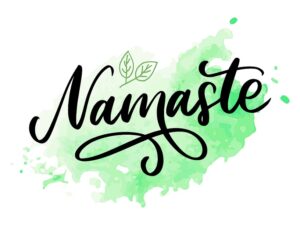
Where did Meditation Originate/Brief History?
The word “meditation” in the English language, actually originates from meditatum (Latin), meaning “to ponder”. The schools of thoughts as to “how old” or “where meditation originated from”, are vast. Some books state it’s as old as humanity. Others discuss the oldest written records, placing the practices origins to India 1500 BCE, where practices having to do with “training of the mind” are referenced.
Forms of meditation are mentioned between the 3rd-6th century BC, China. Fact is, it’s seems difficult, maybe impossible to speculate when meditation, as a practice, originated from and an exact location.
A Deeper Look at The History of Meditation Can Be Found Here!
Meditation (or thought processes that involve much of what meditation is today) have been used throughout history. Furthermore, seen throughout many cultures around the globe. In fact, there are many ways to utilize and experience meditation. Oftentimes, it’s difficult to get a handle on the practice, as there seems to be limitless information. Moreover this information, is sometimes scattered. Thus, making it hard to put the pieces together.
What Is Meditation?
In our opinion, meditation is not a way of changing the person you are. Likewise, thinking that by practicing it, you will in some way become a “better person”. It’s a way of observing or experiencing your thoughts from a different perspective. A non-judgmental perspective. This type of awareness helps us to form a stronger and healthier vision of ourselves.
It’s a sort of “brain training” practice, that takes patience and routine. Meditation, along with it’s varying degrees of techniques, can also lend itself to helping practitioners develop a sense of clarity, increased concentration, a better emotional state and well-being.
Meditation involves self-awareness, spiritual alignment, focus (or engagement) of the mind to truly hone in on “the now” or the present moment. With routine, consistency, focus and understanding of different forms of meditation, you may certainly discover benefits of the practice, you may have never knew existed. As an individual, you may react to certain situations of daily life, different. For example, calmer, and more effective. Thus, finding yourself in a much better and safer place, via mind and body!
Older meditation practices involve a much more spiritual component. However, can depend on the type of meditation being practiced. More modern definitions of meditation, as it has evolved, tend to emphasize self-awareness (focusing on breath, like mindfulness meditation) and benefits such as it’s potential stress-relieving effects.
Is Meditation Safe?
In general, yes meditation is a safe practice, according to the National Center of Complementary Integrative Health (NCCIH). However, keep in mind, like other practices such as yoga, meditation does have varying forms of “movement-based” meditation. It’s important to keep in mind physical limitation in this aspect.
What does the research say?
A study published online by Cambridge University Press, 2020, sought to “analyze prevalence in harm from mindfulness-based stress reduction (MBSR)”, like meditation. Results indicated that the involvement in MBSR did not correlate or was “not in fact predictive of increased rates of harm, relative to no treatment”. In fact, it seems to be just the opposite!
As with any form of therapy or treatment, it’s important to continue to investigate and research best practices. Specifically, regarding individuals with physical, emotional or mental limitations. Hopefully we will continue to see safe, positive benefits from this ancient art form.
What Are Some of the Potential Benefits of Meditation?
As we go along in this post, we’ll discuss different types of meditation, more in depth. Fact is, as we entered the 21st century, there has been a much more science-based approach to many things we face daily, certainly as it pertains to our health and wellness.
The practice of meditation as well as many other alternative therapies (like yoga, certain diets vs. prescription drugs, music therapy, acupuncture, acupressure, and even massage therapy) are now more researched then ever. Much of the anecdotal evidence on the benefits of specifically meditation, are now being seen in research studies.

Each type of meditation offers something different. In fact some offer tools that can be used as aides to better your experience (like individual techniques within a session). Understand that much of the science behind meditation, focuses on specific practices within mediation. This includes:
- mindfulness meditation,
- transcendental meditation,
- guided-meditation,
- body-scan mediation,
- and approaches that use visualization as a main component.
Other forms of meditation (or techniques within a meditation session) include walking meditation, Zen meditation, yoga meditation, loving-kindness meditation, and mantra meditation, to name a few!
I. Effects On Stress/Anxiety/Depression (including symptoms of):
Probably one of the most prominent benefits (we’ve found) that’s been studied, is the role meditation may have within the domain of stress/anxiety-relief (including symptoms).
This could include;
- psychological,
- physical,
- as well as, psychosocial stress.
Research on this subject matter also included symptoms of stress-related conditions, like IBS, PTSD, fibromyalgia, even improvements in eating patterns.
Oftentimes stress, whether physical or mental, leads to conditions such as some of the following we discuss.
a. Psychological Stress:
A large systematic review of 47 trials and 3515 participants, conclude that meditation programs, specifically mindfulness meditation, showed small to moderate reductions of psychological stress, while still pointing out the needs for stronger studies.
A RCT or randomized control trial looked at the effects of mind-body intervention (Transcendental Meditation) on blood pressure, psychological distress and coping in college students. Meditation demonstrated potential in reducing the risk for future development of hypertension in young adults.
b. Immune Support:
Decreased stress associated with MBSR programs leading to enhanced psychosocial well-being, has even been linked to corresponding changes in blood tests result, like markers of immune activity.
In one study, 24-participants completed assessments pre- and post MBSR interventions. The results showed not just significant improvements in anxiety and overall distress, but were also associated with reductions in immune markers, such as, c-reactive protein (CRP) and increased NK (natural killer cell) cytolytic activity.
c. PTSD:
As for individuals struggling with PTSD or post traumatic stress disorder, according to one study meditation appears to be effective for those that suffer from PTSD and depression symptoms.
d. Gut Health/Eating Habits:
Investigations and research has also went into meditation and stress reduction. Specifically, as they relate to gut health/disorders, like IBS and ulcerative colitis. One such study sought to investigate the role MBSR may have in reducing flare-ups and quality of life of patients with moderate to severe UC (ulcerative colitis).
This study in particular, suggested an improvement in QOL or quality of life, however did not affect the rate or severity of flare-ups.
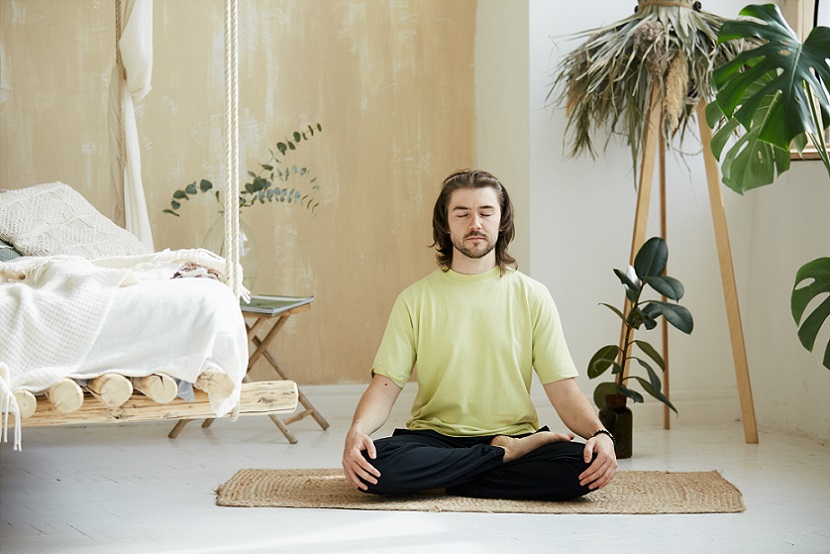
e. Pain Relief:
Meditation has also been reported to have positive effects on certain types of pain management. According to Healthline, “your perception of pain is connected to your state of mind”.
Having said this, one may pose the question as to whether meditation may be effective in:
- helping to control bouts of acute pain,
- helping reduce perceptions of chronic pain,
- or helping to decrease stress associated with pain in general?
Some research has suggested potential benefits of meditation interventions in relation to pain. Like this published 2016 systematic review and meta-analysis of mindfulness-based meditation interventions. This analysis looked at 38 different studies. Concluding that this type of meditation in fact does help with improving pain, depression and quality of life. However, more “large-scale, well-designed” studies are needed to prove efficacy for chronic pain.
Another meta analysis on meditation programs (for psychological stress and well-being) included the enrolling of 3500 participants, over 47 trials. Again, concluded that meditation was associated with decreased pain. However, referencing the need for “stronger study designs” from the standpoint of meditation programs on improving mental health and stress-related behavior.
We think this goes to show the importance of further research, well-executed study design, as well as more randomized controlled trials.
With this being said, cognitive behavioral therapies, continue to play a significant role in therapy for disorders like FM or Fibromyalgia, according to one study. Meditation in specific is referenced as having a “significant role” in improving pain symptoms and pain perception for these patients.
f. Hormone/Inflammatory Response:
Meditation or mindfulness-based practices have also shown to have influence on cortisol levels. Cortisol (a human hormone) is usually produced by increased levels of mental and/or physical stress. Chronic bouts of increased cortisol can “produce many of the harmful effects of stress“. Thus, potentially leading to increased blood pressure, fatigue, even sleep difficulties.
Meditation or mindfulness practice may have a positive influence on the reductions of such hormones and chronic inflammation within the body. An 8-week long study showed positive effects, or reductions in inflammatory responses caused by stress.
II. Smoking Cessation/Fight Addictions:
Along-side some of the stress related benefits of meditation, mindfulness training has been studied for it’s ability to help aid in addictions. For example, smoking cessation, or alcohol use.
One particular study looked at mindfulness training compared to the American Lung Association Freedom from Smoking Treatment (FFS). The mindfulness-based group showed a greater rate of reduction in cigarette use during and after treatment.
A systematic review of mind-body practices (like yoga and meditation) included 14 clinical trials. Both showed “promising effects”. Hence, supporting the need for future studies and investigations on mind-body practices on smoking cessation.
Among smokers in another trial, after 2 weeks of meditation training, meditation efforts seemed to produce a significant reduction in smoking (60%). This study also reveled “resting state brain scans showing increased activity for the meditation group in the anterior cingulate and prefrontal cortex”. These areas, according to the study, are important for self-control.
III. Attention Span/Focus/Self-Awareness:
Based on what meditation is, it’s probably no surprise it’s effects on attributes like attention span, focus and self-awareness. Meditation in general, helps you to get a better understanding of self, and the present, by aiding in training the mind.
As an article on Cambridge University News in 2021 states, meditation can help pull you away from the never-ending “what could have been”. Furthermore, meditation helps to not just connect your mind-body, but it helps to focus and/or refocus your thoughts as they may begin to wonder.
In one study of a 10-minute meditation tape session, individuals showed better accuracy on a flanker test. Read more about i here. Another study showed that people who routinely practiced mediation did better on visual tasks. Additionally, with a greater attention span than those with no prior or current meditation practice.
Practices such as yoga and meditation, and other higher level “non-judgmental awareness” practices “may help in obtaining a better-adjusted and resilient self”.
Important to note: The National Center for Complementary and Integrative Health does discuss the lack of studies for meditation for ADHD.
IV. Sleep Disorders (Insomnia Specifically):
Next, we discuss the potential role of meditation on sleep disorder, like insomnia.
In a 2014 published randomized control trial, 54 adults with chronic insomnia were assigned to mindfulness based stress reduction, mindfulness based therapy for insomnia, or an 8-week self monitoring condition. The study concluded that mindfulness meditation is a viable option for adults that suffer from chronic insomnia. The study went on to say it could be an alternative to traditional treatment for the disorder.
Another study concluded that the use of a community-accessible mindful awareness practice intervention resulted in better sleep quality, less insomnia, fatigue and depression, which may help to reduce sleep related daytime impairment.
V. Highly Accessible Practice
Last, but certainly not least, has to do with accessibility. One of the best qualities of the practice is that while it’s principles are intact, it has evolved in a way that has allowed for it to be accessible anytime, anywhere.
The opportunities are there for you to practice, literally anytime of the day. The accessibility of the internet as well as even mindfulness meditation apps like headspace and calm, have also contributed to the ease of use, as well as the education you need.
To many, meditation is as routine as eating breakfast or brushing your teeth in the morning. Others fit their sessions into their day as they go, and that’s okay.
However you decide to embarked in your journey within the practice, we hope this information as helped. Whether that be getting you started or simply having batter understanding understanding of the discipline.
Below you will find some additional information about some different types of meditation.
What Are Some Of The Different Types of Mediation
1. Mindfulness Meditation
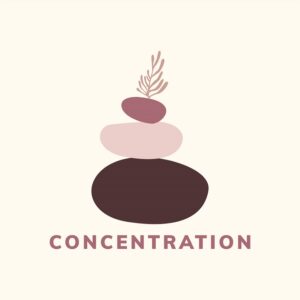
Mindfulness Practices (+) Meditation.
Mindful meditation is one of the largest growing forms of meditation practiced today, all over the globe. This form of mediation has grown in popularity, especially in western countries. Mindfulness meditation has its roots in Buddhism. There is a focus on finding the self and attaining enlightenment through self-knowledge. It’s a practice that aides in mental training. Furthermore, teaching it’s practitioners how to slow there thoughts, calming both the body and mind.
Individuals who practice this meditation-type, begin by extending (focusing) their senses towards the body and their environment, as well as learning to let go of negative emotions. The reality around the individual is acknowledged, however not the main focus. Individuals who partake in this practice, learn to focus and refocus their minds as it may begin to wonder during sessions, all the while, remaining non-judgmental of any thoughts and emotions that arise.
Most of the time, forms of deep breathing becomes a focus to help stay in the now or “present” as well as a way of redirecting the mind.
Through repeated practice, mindfulness meditation helps to control thoughts and helps ground practitioners in the present moment. Thus, giving the practitioner means to potentially, living a more fruitful, less worrisome life.
2. Mantra (chanting-type) Meditation
To understand mantra meditation, let’s first discuss what a “mantra” is. A mantra can be different things to different practitioners. It can be very broad or specific to that individual. Mantra’s can be a syllable, word, or phrase. Regardless, it is most often the same syllable, word or phrase repeated over and over.
Noteworthy, you may not always hear that mantra either. Oftentimes, practitioners repeat the mantra either:
- in their minds,
- others out-loud,
- or at a whisper-type audio.
Mantra meditation is another Buddhist-linked form of meditation. However, it can also be found in the Hindu culture. Instead of focusing solely on breathe or bodily sensations, mantra meditation uses chants to ground the individual in the present moment. Oftentimes, mantra’s are closely linked to mantra meditation or mindfulness mediation practices, or a combination of the two.
Sometimes the chants have personal meaning. Other practices focus only on repeating a word or sound. This is said to help clear the mind and create spiritual balance within. Furthermore, keeping out un-wanted thoughts or emotions. Music or melody can be a part of this type of meditation, it depends on where you are practicing, and individual purpose.
3. Visual-Type Meditation
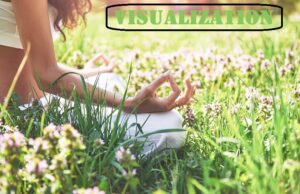
The last “type” of meditation we’ll discuss is visual meditation. Now when we talk about “type of meditation”, visualization is really a strategy or technique used within the practice of various forms of meditation.
When using visualization within the practice, the aim is different then what you may think of with traditional mediation. Usually is about letting thoughts and/or emotions “pass”, focusing on the now. Visualization, is about focusing on an image. For example, this could be a person, place or event. Furthermore, allowing it to guide your thoughts toward a reality that you may want to happen.
Any kind of image can be conjured in your head. The goal here can be two-fold. First, bringing peace and quiet to your mind, decreasing anxiety prior to the actual event. Secondly, allowing your brain to connect to something you wish to happen a certain way or an outcome.
The brain (Amygdala), you see, has difficulty distinguishing between something seen during visualization and an actual event happening. Thus, giving us access to visualize in hopes to lessen anxiety or build confidence around an event, before it as actually occurred.
Related Article: Meditation Breeds Confidence: Meditation for Confidence, Self-Esteem, and Self Worth!
Where to Practice Meditation?
There is no short answer to this. Meditation can be practiced in many different locations. For example, at home (study, bedroom), outside (pool, backyard), a garden, churches, studios, parks, while they’re walking, even in the car.
However, more realistically there are going to be places very personal to some that allow them to sink deeper into the practice. Maybe this “place” provides comfort, peace, tranquility, or extreme quietness.
Sometimes, it’s about trial and error. For instance, you may try a few places and just feel one is superior for you then the others. You may even be someone who prefers to meditate in a group setting, or with guided meditation in a class of some sort. The point is, not only are different forms of meditation very unique and individualized, so are how people go about selecting their space, time, or even objects within their space.
Related Article: Outdoor Meditation: A How-to-Guide & Ideas for Outdoor Meditation Spaces
What A Meditation Session May Look Like? (talk about guided meditation)
Likewise to what we discussed with “best places to meditate”, what the space looks like, depends on the person.
Some prefer very little in the room, just a space with them and their yoga mat (or meditation mat). While others enjoy the sound of running water. Consequently, they may add a water element. Others enjoy warm colors (warm, soft, neutral, etc.). You may simply sit in front of your computer and listen to a guided session, and that works just fine for you.
The outdoor enthusiast may even design an outdoor meditation spaces for themselves. Some enjoy light and bright spaces. While others mimic a professional studio in their home, to some degree.
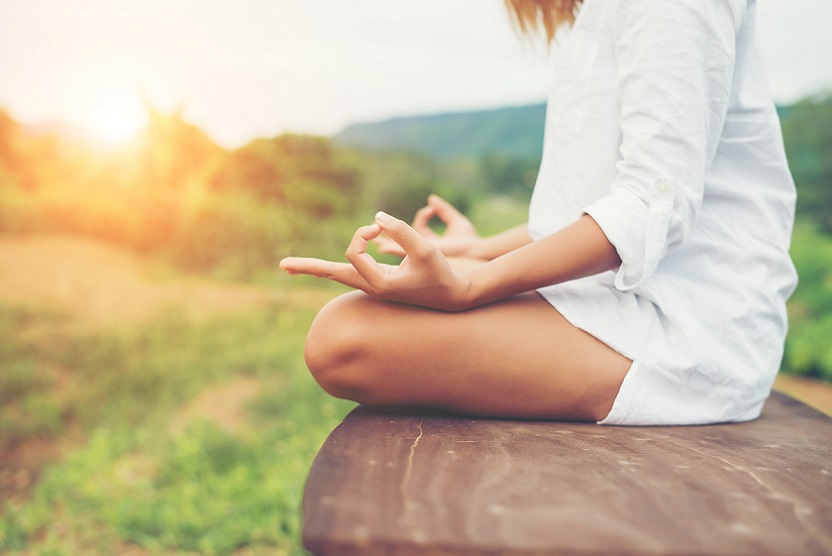
There is no right answer, it’s what works for the you, the practitioner!
Final Thoughts On Different Types Of Meditation!
As with any “therapy”, the more high quality studies that are performed, the better, more accurate knowledge the public will have on these techniques. However, given the current research, meditation seems to be a low-risk, low-cost way to help manage stress, anxiety, even conditions caused by stress.
Regardless of the type of meditation you choose to practice, all of them can offer benefits when done daily and consistently.
For some, the best times to perform meditation is in the morning. This may set you up for a less stressful experience during your daily routines, by calming oneself early in the day.
As always, thanks for stopping by. Please share your experiences with meditation and the positive benefits it’s had on your life in the comments section of this blog.
Have a stress-free day!
Resources:
- https://mindworks.org/blog/history-origins-of-meditation/
- https://positivepsychology.com/history-of-meditation/
- https://www.nccih.nih.gov/health/meditation-in-depth
- https://www.cambridge.org/core/journals/psychological-medicine/article/abs/prevalence-of-harm-in-mindfulnessbased-stress-reduction/A97168BD448E68E12394A66738C0FECE
- https://pubmed.ncbi.nlm.nih.gov/24395196/
- https://pubmed.ncbi.nlm.nih.gov/20455784/ https://www.healthline.com/nutrition/12-benefits-of-meditation#1.-Reduces-stress https://pubmed.ncbi.nlm.nih.gov/23092711/
- https://pubmed.ncbi.nlm.nih.gov/19798037/
- https://pubmed.ncbi.nlm.nih.gov/24557009/
- https://www.healthline.com/nutrition/12-benefits-of-meditation#10.-Helps-control-pain
- https://www.ncbi.nlm.nih.gov/pmc/articles/PMC5368208/
- https://pubmed.ncbi.nlm.nih.gov/24395196/
- https://pubmed.ncbi.nlm.nih.gov/29619620/
- https://pubmed.ncbi.nlm.nih.gov/21723049/
- https://pubmed.ncbi.nlm.nih.gov/23664122/
- https://pubmed.ncbi.nlm.nih.gov/23918376/
- https://pubmed.ncbi.nlm.nih.gov/25141355/
- https://www.ncbi.nlm.nih.gov/pmc/articles/PMC6088366/
- https://www.ncbi.nlm.nih.gov/pmc/articles/PMC5962705/
- https://pubmed.ncbi.nlm.nih.gov/25142566/
- https://www.ncbi.nlm.nih.gov/pmc/articles/PMC4407465/



